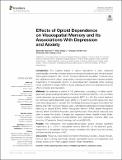Files in this item
Effects of opioid dependence on visuospatial memory and its associations with depression and anxiety
Item metadata
| dc.contributor.author | Tolomeo, Serenella | |
| dc.contributor.author | Davey, Fleur | |
| dc.contributor.author | Steele, J. Douglas | |
| dc.contributor.author | Baldacchino, Alexander Mario | |
| dc.date.accessioned | 2019-10-25T15:30:06Z | |
| dc.date.available | 2019-10-25T15:30:06Z | |
| dc.date.issued | 2019-10-23 | |
| dc.identifier | 259001070 | |
| dc.identifier | 62c377c0-c36e-4836-99a1-6e9e6fb61b97 | |
| dc.identifier | 85074974884 | |
| dc.identifier | 000494682900001 | |
| dc.identifier.citation | Tolomeo , S , Davey , F , Steele , J D & Baldacchino , A M 2019 , ' Effects of opioid dependence on visuospatial memory and its associations with depression and anxiety ' , Frontiers in Psychiatry , vol. 10 , 743 , pp. 1-8 . https://doi.org/10.3389/fpsyt.2019.00743 | en |
| dc.identifier.issn | 1664-0640 | |
| dc.identifier.other | ORCID: /0000-0002-5388-7376/work/63716965 | |
| dc.identifier.uri | https://hdl.handle.net/10023/18778 | |
| dc.description | Funding: Schering-Plough unrestricted educational grant, Anonymous Trust, Indivior. | en |
| dc.description.abstract | Introduction The cognitive impact of opioid dependence is rarely measured systematically in everyday clinical practice even though both patients and clinicians accept cognitive symptoms often occur in the opioid dependent population. There are only a few publications which utilised computerised neuropsychological tests to assess possible impairments of visuospatial memory on opioid-dependent individuals either receiving opioid replacement therapy (ORT) or during subsequent short term abstinence and the effects of anxiety and depression. Methods We assessed a cohort of 102 participants, compromising (i) a stable opioid dependent group receiving methadone-maintenance treatment (MMT) (n=22), (ii) a stable opioid dependent group receiving buprenorphine (BMT) (n=20), (iii) a current abstinent but previously opioid dependent group (ABS) (n=8) and (iv) a control group who have never been dependent on opioids . The CANTAB neuropsychological tasks undertaken by participants included: Delayed Matching to Sample (DMS), Pattern Recognition Memory (PRM), Spatial Recognition Memory (SRM) and Paired Associated Learning (PAL) tasks. Three clinical measures were used to assess the severity of anxiety and depressive illness: HADA-HADD, BDI and ISD-SR. Results The methadone and buprenorphine treated groups showed significant impairments (p<0.001) in visuospatial memory tasks but not the abstinent group. Impairments on visuospatial memory strongly correlated with higher mood and anxiety symptom severity scores (p<0.001). Discussion These results are broadly consistent with previous studies. Uniquely though, here we report a strong relationship between visuospatial memory, depression and anxiety scores, which might suggest common illness mechanisms. | |
| dc.format.extent | 8 | |
| dc.format.extent | 942443 | |
| dc.language.iso | eng | |
| dc.relation.ispartof | Frontiers in Psychiatry | en |
| dc.subject | Memory | en |
| dc.subject | Opioid dependence | en |
| dc.subject | Heroin | en |
| dc.subject | Methadone | en |
| dc.subject | Buprenorphine | en |
| dc.subject | Depression | en |
| dc.subject | Anxiety | en |
| dc.subject | RC0321 Neuroscience. Biological psychiatry. Neuropsychiatry | en |
| dc.subject | RM Therapeutics. Pharmacology | en |
| dc.subject | NDAS | en |
| dc.subject.lcc | RC0321 | en |
| dc.subject.lcc | RM | en |
| dc.title | Effects of opioid dependence on visuospatial memory and its associations with depression and anxiety | en |
| dc.type | Journal article | en |
| dc.contributor.institution | University of St Andrews. School of Medicine | en |
| dc.contributor.institution | University of St Andrews. Population and Behavioural Science Division | en |
| dc.contributor.institution | University of St Andrews. Centre for Minorities Research (CMR) | en |
| dc.identifier.doi | 10.3389/fpsyt.2019.00743 | |
| dc.description.status | Peer reviewed | en |
This item appears in the following Collection(s)
Items in the St Andrews Research Repository are protected by copyright, with all rights reserved, unless otherwise indicated.

